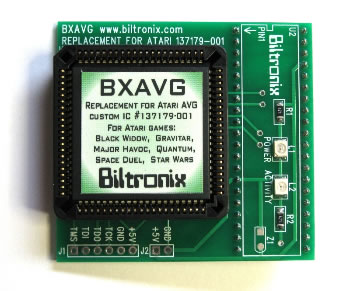The single chip design allows for small board size. With respect to multi-chip TTL AVG replacement boards, the BXAVG dramatically reduces the number of solder joints and components that could eventually fail. The chip used on the BXAVG is a common Xilinx CPLD chip that has been custom programmed to accurately perform all of the functions of the original Atari AVG chip. The result is that your game will perform exactly as it should. The player will not be able to tell the difference because there is no difference in function or performance.
The 'Power' LED indicator lets you know that the module is plugged in and powered up.
The 'Activity' LED indicator flashes at a rate of 2 Hz to 3 Hz to indicate that things are running properly. If the 'Power' LED is on and and at the same time the 'Activity' LED is ever stuck on or stuck off for and extended period of time, there is a problem either with the game itself or with the BXAVG. One exception to this, the game Quantum tends to work for several seconds at a time without the light flashing but it will flash eventually.
The BXAVG module has high quality gold plated round machined pins for easy insertion and a reliable connection.
The BXAVG module now has a voltage regulator and a transient suppressor. These new components should prevent failure of the main chip in the event of a failure of the ARII board or other transient voltage spike occurring on the power supply. The older model did not have these components.
The PCB is 0.625" narrower than the previous design and has rounded corners resulting in a size reduction of 2.2 square inches. I know that there are one or two new designs out there that achieved narrower PCBs by centering the main chip over the DIP headers but I avoided that design for two reasons. First, it forces the elimination of many of the through-holes for header pins in the area of the chip. A few people who bought such modules reported to me that this has led to faulty connections occurring in their games and I didn't want BXAVG users to suffer from that problem. Second, soldering the header pins from the underside is difficult at best and makes assembly more time consuming. In order to make it worthwhile for me to continue to build the modules by hand, the assembly process must remain as simple as possible... not that soldering 0.5mm pitch 100-pin chips is a walk in the park to begin with. Although my design is not the smallest footprint available or possible, I believe it is the most cost effective and robust way to build them.
2014: Why a new design?
The bottom line here is that in 2012, Xilinx discontinued production of the large socketed PLCC84 chip and so the chips are no longer available from reliable sources such as reputable distributors. In fact, the entire 5V line of XC9500 family parts was discontinued. I continued selling the older BXAVG design modules until my stock ran out. The new BXAVG design is more difficult for me to assemble but it does cost a bit less and I passed the savings onto the customers, hence the reduction in price from the old version to the new version.
2011 version pictures:
Note: These photos are for general information only. This version is no longer produced.
Disclaimer: I have designed and built the BXAVG module with the highest level of quality and attention to detail to which I am capable, however I accept no liability whatsoever for any and all damage or inconvenience that may result from its use or from the use or misuse of any information presented on my web pages. You assume all responsibility for your arcade machines and the components that you install into them.
BXAVG Main ---- BXAVG Installation ---- Top ---- Arcade List ---- Home




